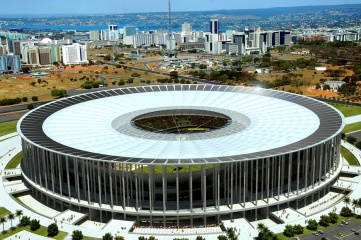The Estádio Nacional in Brasilia produces more solar energy than 11 countries competing in the 2014 FIFA World Cup, according to a report by UK non-governmental organisation Practical Action.
The solar production of Bosnia-Herzegovina, Croatia, Cameroon, Colombia, Costa Rica, Ecuador, Honduras, Iran, Ivory Coast and Uruguay all fall below the 2.5 MW capability of the stadium in Brazil’s capital.
Ghana’s national solar capacity matches that of the stadium, which will host seven matches during the world’s largest single sport event.
Three other World Cup stadiums also have major solar power installations, the Mineirão in Belo Horizonte producing 1.4MW, the Itaipava Arena in Pernambuco producing 1MW and the rebuilt Maracanã in Rio de Janeiro producing 500KW.
These observations were reported by Practical Action on Wednesday, on the back of their new Poor Peoples’ Energy Outlook report.
Simon Trace, CEO of Practical Action said: “The organisers and FIFA are to be congratulated for making a considerable financial investment and making this the greenest World Cup in history.”
The Estádio Nacional in Brasilia cost US$640m stadium, making it one of the most expensive stadiums in history and starkly contrasting with the economic situation of many of the competing nations.
“It is.. an indictment of the investment in renewable energy in the developing world that there are ten competing countries that do not even produce as much solar energy as a single World Cup stadium,” said Trace.
“Currently more than one billion people live without access to reliable sources of energy. Without that, people cannot develop and there will always be a substantial proportion of the world’s population living in poverty.
“Our report found that the only way of reaching the vast majority of these populations is not via traditional grid-based electrification as found in the west, but via smaller scale, renewable off-grid solutions such as solar, hydro and wind.
“It is therefore vital that we follow the example set by the World Cup organisers and invest heavily in the new technology we are seeing used so well in Brazil.”


